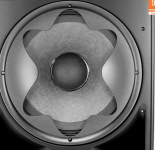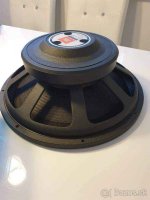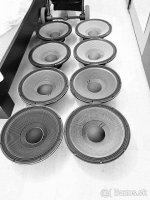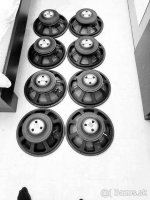Cabinet construction and (total) "system" design are the main ingrediënts of a good, or less than good loudspeaker system imho.
Roundovers, provided they are big relative to the cab dimensions as well as the wavelenghts in question, can have some positive effects.
However, I doubt the roundovers of the Summa (fullrange version) would make BSC redundant.
No doubt about improving the OSWG's performance though.
Roundovers, provided they are big relative to the cab dimensions as well as the wavelenghts in question, can have some positive effects.
However, I doubt the roundovers of the Summa (fullrange version) would make BSC redundant.
No doubt about improving the OSWG's performance though.
Last edited:
...excited is a different question from what they are.
Yes, that's just my point.
The "rim modes" are to be expected but if they are not excited then what difference do they make?
What I did not expect is that they are excited sufficiently to matter.
The JBL stuff shows that they are excited, but how that happens is unclear.
Approximately what sort of levels did JBL report?
...So I don't pay much attention to these details...
My interest is mainly intellectual curiosity- symmetry and symmetry breakdown is a fundamental issue in physics.
Symmetric input should never lead to non symmetric results so there must be some asymmetry somewhere to excite the modes.
So the problem should be completely avoidable.
I take your point that this is less important than the total system concept.
But that's a solved problem
Many years back I also settled on 15" + compression driver + multiple subs.
I don't think it's coincidence we arrived at the same solution.
Probably a bit of confirmation bias there
Best wishes
David
is it possible a design obscures the listeners ability to differentiate fine differences in drivers?
Of course, just like one small bypass cap in a passive crossover can make a profound difference in the voicing of a driver.
Many years back I also settled on 15" + compression driver + multiple subs.
I don't think it's coincidence we arrived at the same solution.
Probably a bit of confirmation bias there
David, do you mind sharing some details of your 2 ways, or do you have a link to a (build) thread?
...some details of your 2 ways, or do you have a link to a (build) thread?
I don't have a build thread, I may put one up once they're finished.
In the meantime I don't want to hijack Marcel's thread so I will keep it brief.
JBL 2226 woofers, this is a pretty nice 15", ribbon voice coil, etc.
This is in a 4 cubic foot sealed enclosure, well damped with acoustic fibreglass.
Subs are JBL 2245 18", not their latest, even at the time I built the system but well suited to domestic use if one has the space, the later subs are optimised for robustness and use in multiples- where they couple.
Boxes are vented, 10 cubic feet, lined with lower density fibreglass.
All boxes are marine certified ply, 3/4" damped with a bituminous mastic.
Next step is to add a constrained layer of 3 mm aluminium to further damp the boxes and improve thermal dissipation.
Probably overkill for domestic use but I occasionally take them to parties.
Compression driver is JBL 2453, 1.5" throat.
Crossed at ~700 Hz, currently passive, the plan is multi-way active eventually.
I use temporary, cobbled up horns, the current project is to build the definitive horn for the system.
Planned ~80 x 50 dispersion and well rounded mouth transition.
Hence my participation in this thread- for the horn simulation.
I arrived at the system concept and specification independently but it's consistent with consensus best-practice, I'd say.
Best wishes
David
Last edited:
In the context of this thread and 800hz xover between the compression driver: why the choice of a 15" over lets say a 12" or a pair of 10"? Seems like the smaller woofers would play cleaner upper mids...
a 15 matches the directivity of the horn at the crossover frequency. If you use a smaller driver then it will be too wide. Your thinking works well with a typical PA because they are crossed much higher (1200-1800 normally)
What about say 7 x 6" in a flower-like pattern? I don't remember if I ever saw something like that. Wondering how suitable the directivity around the crossover would be, compared to a single 15". Or in case of a rectangular horn, the pattern could be rectangular as well (e.g. 2 x 3 drivers).
Last edited:
...how suitable the directivity around the crossover would be...
A circle of 6 around a central driver would be very close to a similar total size circular driver surely?
JBL have a few pro-audio enclosures with 4 drivers in a diamond pattern.
An externally hosted image should be here but it was not working when we last tested it.
Oriented to narrow the vertical directivity compared to the horizontal.
Makes sense for pattern control if you need 4 drivers anyway for power reasons but hard to justify the expense for a domestic system.
A pity, the idea is nice.
I have considered a pair of smaller drivers to move the acoustic centre closer to the horn and reduce the directivity unevenness around the crossover frequency.
Best wishes
David
Last edited:
I would think so, with the advantage of being cleaner around and especially little above the crossover frequency, as most of 15" have very little margin there. There may be "gotchas" however.A circle of 6 around a central driver would be very close to a similar total size circular driver surely?
Last edited:
... cleaner around and especially little above the crossover frequency...
By "cleaner" you mean lower distortion or smoother/less resonances?
As you say, many of the 15" are not ideal near cross-over but the JBL 2226 is low distortion and smooth with little in the way of resonances, just a roll off past >1Khz, two of the reasons I picked it in the first place.
I would stay with a 15" if I had to do it today.
A few of the new drivers are even better, plus there's probably some nice ones I don't know of in the vast number released over the last 2 decades.
Best wishes
David
Last edited:
I mean smoother response, i.e. less resonances, for the most part.
Yea, JBLs like those yours look very good. When I think of woofers I usually don't have JBL in mind as these are not so common here (even though I can buy them new here for 429 €/piece). BTW, could you share some acoustic data on your project?
Yea, JBLs like those yours look very good. When I think of woofers I usually don't have JBL in mind as these are not so common here (even though I can buy them new here for 429 €/piece). BTW, could you share some acoustic data on your project?
- I tried to estimate a typical speed...from the first break-up modes...and it seems to be only a several times...the speed of sound in air...
This reminds me of an issue that I have wondered about for a while.
I have seen presentations about the use of different materials in compression driver domes (mostly by the beryllium salesmen).
They compared the difference in speed of sound.
But if break up is into bend modes then that is not the correct comparison.
Stiffness for a bend mode doesn't scale linearly, so less dense but less stiff materials like aluminium should perform better than titanium even if the stiffness to density (hence speed of sound) is practically identical.
You probably do need a full FEA do this realistically.
Probably not much use unless you can fabricate your own compression drivers so I never followed it up, but thanks for the reminder.
I had hoped to eliminate excitation of the bend modes but I now realise this is not possible.
Best wishes
David
When I think of woofers I usually don't have JBL in mind as these are not so common here...
When I started there was not much other choice for serious components, especially in the US.
Now there's BMS, B&C, Beyma, 18Sound and many others.
But JBL's are still pretty nice.
BTW, could you share some acoustic data on your project?
Not yet, I plan to eventually but kind of derailed by virus lock down and my slow work pace.
Today all I achieved was to build the trolley to move the boxes around.
16 cubic foot boxes in 3/4" ply plus braces, fibreglass and JBL 18" and 15" drivers and material to dampen the walls = heavy.
Best wishes
David
Last edited by a moderator:
2 Examples:
I just looked at this closely and noticed it shows little evidence to support the idea that the circumferential (AKA rim) modes are excited much.
The FEA shows the possible rim modes, as expected, but the actual laser data is fairly axisymmetric.
The laser data looks a bit noisy, but initial impression is that I don't see much evidence of excitation of rim modes.
Is it clearer in other pictures in the paper?
It does, however, nicely demonstrate Earl's point that the modes are not those of the classic circumferentially clamped membrane.
Best wishes
David
Last edited:
A couple of comments.
I agree with Dave that we have to be careful with sound velocity since in a plate there are two types of modes, both compression (in-plane) and bending. Both exist and can couple with each other. At LFs this effect is small but at higher frequencies, it can be much larger. Hence axisymmetric drive can couple to nonaxisymmetric modes through this coupling. Again, this is a fairly small effect, but can happen.
Also, the wave velocity of bending waves is dispersive, meaning that it is not constant with frequency. This also complicates things to a very large extent.
Lastly, I have seen waveguides that are quite comparable to a pure OS, but I have yet to see one that is notably better.
I agree with Dave that we have to be careful with sound velocity since in a plate there are two types of modes, both compression (in-plane) and bending. Both exist and can couple with each other. At LFs this effect is small but at higher frequencies, it can be much larger. Hence axisymmetric drive can couple to nonaxisymmetric modes through this coupling. Again, this is a fairly small effect, but can happen.
Also, the wave velocity of bending waves is dispersive, meaning that it is not constant with frequency. This also complicates things to a very large extent.
Lastly, I have seen waveguides that are quite comparable to a pure OS, but I have yet to see one that is notably better.
Scanning Laser Doppler Vibrometer (SLDV) data of an Electro-Voice ND6 without and with horn.
Attachments
-
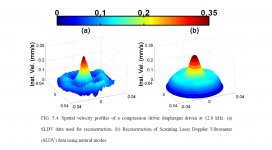 Spatial velocity profiles of a compression driver diaphragm driven at 12.8 kHz..jpg386.4 KB · Views: 281
Spatial velocity profiles of a compression driver diaphragm driven at 12.8 kHz..jpg386.4 KB · Views: 281 -
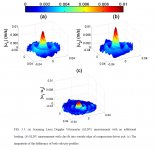 Comparison of the compression driver with and without clay in the outside channel of the driver .jpg499.5 KB · Views: 122
Comparison of the compression driver with and without clay in the outside channel of the driver .jpg499.5 KB · Views: 122 -
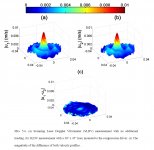 Comparison of the compression driver with and without the horn.jpg495.6 KB · Views: 121
Comparison of the compression driver with and without the horn.jpg495.6 KB · Views: 121
Last edited:
- Home
- Loudspeakers
- Multi-Way
- Acoustic Horn Design – The Easy Way (Ath4)
